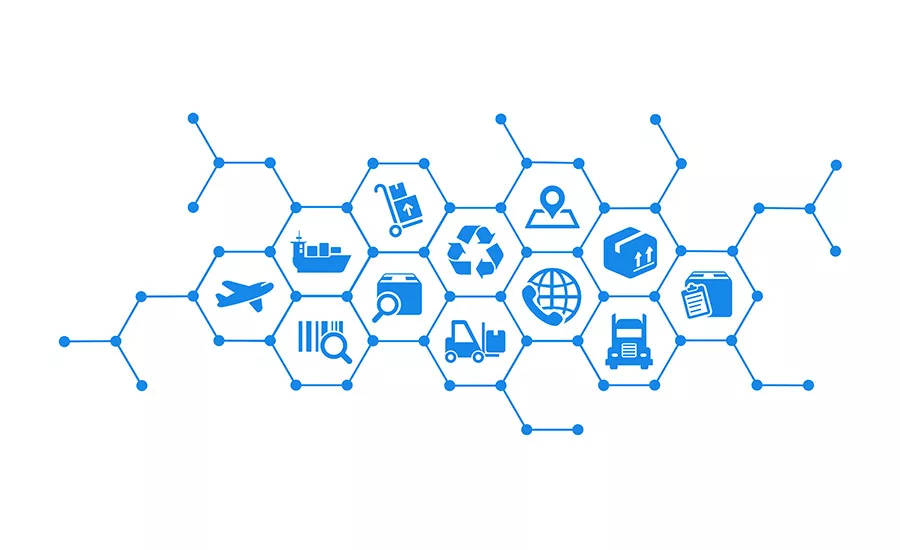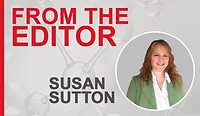Ongoing Supply Chain Challenges Impacting the Adhesive and Sealant Industry
I recently reached out to key players in the industry to find out what supply chain issues are still in play and how companies are mitigating the various challenges, as well as their projections for the future.

The supply chain has seen several major disruptions over the last 20 months or so. As a result of various issues arising from the beginning of the COVID-19 outbreak and the pandemic’s extended impact to natural disasters and more, the adhesive and sealant industry has been dealing with lack of supply, supply and demand disparities, and logistics complications, to name just a few.
I reached out to key players in the industry to find out what issues are still in play and how companies are mitigating the various challenges, as well as their projections for the future.
What major supply chain challenges continue to impact the adhesives and sealants industry?
Dietmar Dengler, Ph.D., Head of Chemistry and Risk Management, DELO: The availability of raw materials is certainly the main concern. Logistics is also extremely important and directly connected to raw materials. Since the start of the pandemic, freight capacity and freight rates have become an issue. Shipping has become expensive, but even more, it has become very unpredictable. The effects of port and airport closures due to COVID cases should not be underestimated.

Dietmar Dengler, Ph.D., Head of Chemistry and Risk Management, DELO
Apart from these closures, there is a supply shortage of ship containers. Air cargo capacity is still limited due to the reduced number of intercontinental flights. While logistics experts know how much cargo passenger flights can transport, this is a fairly new insight for the general public.
When looking at logistics from a global perspective, we see that the capacity in the U.S. is higher than in Europe. The U.S. pays higher prices, with routes from Asia to Europe being redirected to America. This creates a bigger logistical issue in Europe than it does in the U.S.
Rob Hubbard, Vice President, Global Strategic Sourcing, H.B. Fuller: The two major challenges to receiving desired amounts of goods on time currently are: logistics challenges and high demand outpacing supply. In the first half of 2020, demand dropped dramatically, and many production assets were throttled down or shut down because of COVID-19. This major disruption to the world’s normal flow of goods caused shipping containers and shipping vessels to become imbalanced.

Rob Hubbard, Vice President, Global Strategic Sourcing, H.B. Fuller
In the second half of 2020, consumer demand surged at an unexpected rate to very high levels. As a result of this fast rise in demand, supply was initially caught off guard. Demand continued to outpace supply into 2021, and then the cold weather event that struck Texas and Louisiana further constrained supply. As of today, supply has not caught up with the ever-increasing demand in the petrochemical space. Most markets remain short, which is continuing to push prices to record levels.
The lingering logistics challenges mean lead times are much longer and delivery times are unreliable. This is especially true for goods shipped transoceanic. Nearly 40% of the world’s chemicals are sourced from China, and most companies in the adhesives and sealants industry are being impacted to some degree. And, limited domestic supply of some materials, like MDI in the U.S., has caused us to increase supply from offshore production sites. This has involved incrementally higher transportation costs, longer lead times, and unreliable delivery dates.
Unreliable deliveries also are forcing many companies to increase normal inventory levels where possible, negatively impacting working capital and increasing costs.
Björn Neal Kirchner, Corporate Vice President Global Supply Chain, Henkel Adhesive Technologies: Like many other companies, we are currently experiencing significant pressures in the global supply chain, which are due to a combination of various factors. These still include well-known impacts from the COVID-19 pandemic and the extreme winter weather conditions in North America at the beginning of the year, which have been hitting the U.S. petrochemical production center, massively disrupting production and logistics in an already tight market. Global supply chains were also affected by logistical issues, for example in the context of the Suez Canal blockage.

Björn Neal Kirchner, Corporate Vice President Global Supply Chain, Henkel Adhesive Technologies
In addition, a strong recovery in multiple industrial segments and continued high demand in consumer goods markets is meeting relatively short supply capacities. These two factors caused an all-time high in force majeure situations and supply disruptions globally, and as a consequence sharp increases of direct material prices and transportation cost.
Julie Vaughn, Global Business Development Director, Emerald Kalama Chemical LLC (now part of Lanxess Polymer Additives): After 2020, everyone had hoped for a return to normal. However, 2021 brought a new set of challenges, starting with the winter storm Uri, then Hurricane Ida, logistics issues, and labor shortages coupled with strong demand. This has wreaked havoc on the supply chain in a number of ways: cost escalation for materials, labor and transit costs, and significantly extended transit times.1

Julie Vaughn, Global Business Development Director, Emerald Kalama Chemical LLC
Given that many adhesives and sealants products contain a dozen or more ingredients, many details must now be micromanaged to maintain pace with strong but fluctuating demand. This not only impacts purchasing and supply chain but also every other function in the organization that touches operations and the customer. Many companies have redeployed some of their R&D resources to focus on approving alternative suppliers and adjusting formulations as a part of critical business continuity action plans.
Which materials are currently most affected by supply chain concerns?
Dengler: These days, it is more of a question of which materials are not affected by supply chain concerns. In the adhesive industry, it’s acrylates, epoxies, isocyanates, and phosphorous chemicals, as well as basic plastics that are widely used for packaging, like polypropylene. The pandemic has contributed to this shortage and has shown how the global economy and a variety of different industries are intertwined. With many lockdowns and reduced mobility worldwide, the demand for kerosene, gasoline, and diesel collapsed dramatically at the height of the pandemic. Because of this, refineries quickly needed to stop production because their storage capacity was reached. Ethylene and propylene, as well as other commodities, are side products of refining oil that could no longer be produced. As a result, the demand for such basic chemicals quickly exceeded their supply, leading to a shortage of many chemical products.
Hubbard: Because chemicals are the building blocks for nearly everything produced, chemicals are short due to very high demand. Materials coming from non-domestic sources are especially affected by logistics challenges.
Kirchner: We are experiencing impacts across nearly all technologies and materials of our broad portfolio. Based on the current market situation, silicone sealants are the most affected material as the capacities are highly concentrated in Asia and thus imbalanced across regions. The supply to North America and the European Union is affected by the current energy situation in China, with power cuts across the country. On top of that, we are facing the trade conflict between China and the U.S. and increasing logistics costs.
Vaughn: One purchasing manager I met recently described the situation aptly as: “What’s the problem ‘this week’?” The U.S. petrochemical industry manufactures 13% of the global demand, and Texas and Louisiana together produce 80% of the U.S. primary petrochemical supply.2 Winter storm Uri took about 60% of the U.S. ethylene and propylene production offline and also impacted chlorine and butadiene. Hurricane Ida further disrupted production in Louisiana, with companies safely shutting down ahead of the storm. That said, Ida affected six facilities producing ethylene in the region, accounting for roughly 16% of U.S. ethylene capacity, according to IHS Markit,3 and further pushing up prices.
These events have had a massive downstream impact, as they are critical feedstocks for key polymers, especially those used in adhesives and sealants. ChemQuest provided an excellent diagram mapping out the supply chain from natural gas and crude oil to the transformation to key polymers and additives.4 These include acrylic, PVA, VAE resins, polyols, polyolefins, epoxies, and butadiene-containing rubber and block copolymers.
Further, converting silicon to other products such as silicone polymers requires high energy, a challenge given China’s energy shortage. This may drive a shift from silicones to other polymers in sealant applications, such as polysulfides and hot-melt systems.
Which end-use sectors are currently most affected by supply chain concerns?
Dengler: Depending on their prevention strategies, it becomes obvious that industries differ in the extent to which they are affected. From the sectors we are active in, the auto industry is most affected. Apart from the known chip shortage, there are also supply issues with other materials, like basic plastics. The consumer electronics industry is finding it difficult to produce the number of pieces that it would like.
Hubbard: Nearly every end-use sector is affected; there are very few exceptions. We are seeing it practically across the board, and where we aren’t seeing shortages as pronounced is where supply is abnormally high due to high capacity.
Kirchner: We see impacts across all our business segments, from consumer and DIY products to construction, packaging, and industrials such as electronics and automotive.
Vaughn: The tightness in raw materials has impacted pretty much every end-use sector in adhesives and sealants. The challenges in logistics, port congestion, and driver shortages have impacted us all.
What steps has your company taken to alleviate or compensate for supply availability issues?
Glen Bowen, Head of Sales–Polymer Additives North America, Lanxess Corp.: This has been a topic of conversation at every conference and meeting. Relationships are important, and a “no-surprises” approach to communications is key. Increased, in-depth, and transparent communication with suppliers and customers has been critical to understand capabilities, planned forecasts, schedules, and developing contingencies.

Glen Bowen, Head of Sales–Polymer Additives North America, Lanxess Corp.
Our company also has multiple manufacturing locations and suppliers in a number of product lines. Wherever possible, we have worked to shift things around in order to overcome constraints. We have also made alterations to our logistics network, specifically in how and where we stock material to compensate for challenges in transportation.
Dengler: In my opinion, many companies have just optimized material costs for many years without evaluating the risks of this approach. Risk management needs a proper role within the management system of companies. Even a missing screw can have devastating results. At DELO, we have always taken risk management very seriously, even in good times. We pride ourselves on giving quality and reliability of our suppliers a much higher priority than raw material prices.
This is a result of our business model. Most of our customers use our premium products for expensive, high-quality, and highly automated production lines. If these lines were to stand still due to adhesive supply issues, the costs would be much higher than the money they could save when using an inexpensive adhesive with raw materials from cheaper, less reliable suppliers.
So even in non-pandemic times, we had a very large stock of raw materials. As we saw COVID approaching last spring, we even doubled our already large stock.
We did not stop there. We have been using a dynamic risk management system for all our raw materials. On the one side, it looks at our demand, based on customer forecasts and our predictions, and at availability on the other side. A traffic light system tells us which raw materials we can relax on and for which we need to act.
To create this data, we have been in communication with our suppliers and invested a lot of effort in properly understanding their supply chains. That way, we are made aware early when a shortage of a pre-commodity arises, and we can adapt. This is a big investment of manpower, as chemical supply chains are extremely complex. In some cases, you need 20 pre-materials for a final material, and you need all 20 of these. And if you use a few hundred raw materials in your production, you get a sense of what my team and I have been busy with for the last 18 months.
In case a supplier has problems shipping goods, you need alternatives. In this instance, we were able to use our second sourcing options that we had built and qualified in previous years, always knowing that second sourcing is more expensive than single sourcing. Also, we could use our own chemical synthesis in which we can produce raw materials on our own—not just on a lab scale but on a production scale.
With risk management always having been a top priority and having conducted all these measures, we did not need to postpone a single scheduled production order due to raw material shortage within the last 18 months. That’s a big success.
Hubbard: For many years, H.B. Fuller has taken a proactive, strategic approach to building strong relationships with our suppliers. We truly consider our suppliers to be partners, and the resulting collaboration has enabled us to secure the materials we need to meet growing customer demands, despite countless external challenges across the global supply chain.
It is nearly impossible to succeed in short markets, like we’ve experienced over the past 18 months, without the preparations we made in the years leading up to 2020. Our preparations leverage the best practices of strategic sourcing. We routinely look for ways to create value in the supply chain as opposed to taking value from our suppliers. This collaborative win-win approach has helped foster strong, healthy relationships with our suppliers, which have been key to our procurement success in these most challenging times and have helped grow our topline results throughout 2020 and 2021.
Kirchner: At Henkel, we are working very closely with our customers and have installed crisis teams to mitigate challenges and steer our supply base with full commitment of the teams. Our Supply Chain team has the tools and processes to proactively detect supply risks and to quickly decide on appropriated actions. As a result, we could avoid even more significant impacts on our operations in Adhesive Technologies and in customer supplies. In addition, we are constantly adapting our sourcing strategy to stay agile and flexible and are also closely working with our strategic global suppliers and partners.
What are you anticipating in terms of supply chain volatility in the 2022 first quarter? First half?
Dengler: Over the summer, I was actually very optimistic that the chemical supply chains would be back to normal by Spring 2022. But what I see now is that refineries have been operating at full load for quite some time. Many of them will need maintenance next year. This will stop production for several weeks (a normal maintenance can last for two months). I don’t expect raw material supply to be much better next year.
This is accompanied by extreme price increases. Some raw materials are three times more expensive than before, others 10 times. The world hasn’t seen such a seller’s market before.
With regard to logistics, supply chains are still quite catastrophic. And as the pandemic isn’t over and won’t be for some time, I don’t expect that logistics capacity and reliability will become better anytime soon.
Hubbard: We are beginning to see some improvements. Big petrochemical assets are running well now, and feedstocks are being produced. It is important to watch consumer spending in the major economies around the globe, which will continue to perpetuate supply chain issues.
Barring a major economic disruption that would lead to a big drop in demand, we expect demand to continue to outpace supply. We expect inventories up and down the supply chains will remain insufficient, and inflationary pressures will continue throughout 2022. In addition, logistics challenges are anticipated throughout 2022.
Scott Kellogg, Head of Global Supply Chain, Lanxess: We are working our way out of the raw material volatility that has been attributed to storms Uri and Ida from this year. That said, weather-related events occur every year; companies and municipalities need to continue to improve their response and reduce the impact of such events.

Scott Kellogg, Head of Global Supply Chain, Lanxess
Return of inventories for the full suite of raw materials to the pre-pandemic levels needed for “smooth” operating throughout the supply chain is still ongoing, likely through the second quarter of 2022. We do not see improvements in the logistics situation during this timeframe due to systemic issues that will take time to work out.5
For example, the “megaports” in the Los Angeles/Long Beach area receive over 25% of all U.S. imports. The congestion at megaports such as these to offload the containers is not the only problem; the underlying lack of truck drivers and nearby storage (25% short) create further constraints.6 While new equipment will alleviate the problem longer term, this takes time to build and deploy. Use of alternative ports may alleviate this to some extent, but driver5 and equipment challenges will remain. Industry experts expect the situation to improve either later in 2022 or early in 2023.
Kirchner: From today’s point of view, the situation in global supply chains will likely continue to remain challenging in the foreseeable future, in terms of cost and availability for both materials and logistic services. We do not expect significant improvements of the overall situation across the first half of 2022.
For additional details, visit www.delo-adhesives.com, www.hbfuller.com, www.henkel.com, and https://lanxess.com.
Note: Opening image courtesy of IIIerlok_Xolms via gettyimages.com.
References
1. T. Gryta and T. Francis, “Companies Strain to Meet Demand: Raw Materials Shortage hurts their ability to profit from rebound in the US,” Wall Street Journal, https://www.wsj.com/articles/from-apple-to-dominos-pizza-u-s-companies-scramble-to-meet-surge-in-demand-11619958601.
2. Chemical Manufacturing Supply Chain, Texas Comptroller of Public Accounts, October 2021, https://comptroller.texas.gov/economy/economic-data/supply-chain/2021/chem.php.
3. Zacks Equity Research, “Will Hurricane Ida Put a Dent on Chemical Industry’s Q3 Earnings?,” October 16, 2021, https://www.entrepreneur.com/article/391627.
4. D. Murad, “Fundamentals to Ensure Sustainable Growth: Strategic Insights for Mid-Decade Business Planning. Are you Ready for 2025?,” presented at Coatings Trends & Technologies, September 2021, https://www.pcimag.com/events/2734-fundamentals-to-ensure-sustainable-growth-strategic-insights-for-mid-decade-business-planning-are-you-ready-for-2025.
5. P. Tirshwell, “Behind your long wait for packages,” Wall Street Journal, June 2, 2021, https://www.wsj.com/articles/behind-your-long-wait-for-packages-11622653994.
6. N. Goodkind, “A shortage in truck drivers is creating supply chain problems and it is about to get worse,” Fortune, October 28, 2021, https://fortune.com/2021/10/28/truck-driver-shortage-supply-chain-80000/.
Looking for a reprint of this article?
From high-res PDFs to custom plaques, order your copy today!









